Abstract
Phase change energy storage materials have been recognized as potential energy-saving materials for balancing cooling and heating demands in buildings. However, individual phase change materials (PCM) with single phase change temperature cannot be adapted to different temperature requirements. To this end, the concept of fabricating different kinds of microencapsulated PCM (MEPCM) and combing them to form a multiphase change material (MPCM) for multi-seasonal applications in buildings has been proposed. To prove the feasibility of this idea, three kinds of MEPCMs were fabricated and used for the development of three different composite MPCMs, classified as MPCM-1, MPCM-2, and MPCM-3. Analysis of the results shows that each MPCM sample was able to release latent heat at two different temperatures thus making them suitable for multi-temperature thermal energy storage applications. The phase change temperatures of the MPCMs were however found to be slightly reduced by 0.09–0.31 °C as compared with the MEPCMs samples. The measured energy storage capacities for the MPCMs were also reduced in the range of 6.3–11.4% as compared with the theoretical values but they displayed relatively good thermal stability behaviour of up to 197.8–218.8 °C. It was further identified that the phase change temperatures and latent heat of the MPCM was attributed to the weight percentages of individual components, as the theoretical values for the three MPCM samples were all in good accordance with the measured values. Therefore, optimizing the weight ratios of the MEPCM in MPCM samples and their corresponding thermophysical properties based on specific climatic conditions would be a necessary step to take in future investigations. Thermal performance enhancement of the MPCM is also being recommended as an essential part of further research.
1. Introduction
Phase change materials (PCMs) have been proven as potential energy-saving materials for balancing heating and cooling loads in buildings [,,]. For instance, microencapsulated phase change materials (MEPCMs) could be incorporated into cement [], mortar [], gypsum, concrete [], plaster, MEPCM slurries [], and other construction materials [] to enhance the thermal energy storage capacity [] and performance of buildings [].
Past studies carried out by various researchers have highlighted the potential of integrated MEPCM systems in the context of heating and cooling loads within buildings. For instance, the investigation by Zhou et al. [] established that an integrated laminated MEPCM gypsum board was able to reduce the internal room temperature by 5 °C thereby significantly reducing the building’s dependency on external energy sources for heating and cooling purposes. Similarly, Young et al. [] and Berthou et al. [] employed an array of experimental and computational approaches to quantify the impact of MEPCMs on energy use and demonstrated that a well-designed MEPCM system can result in marked reductions in buildings. However, these systems are unable to be tuned up for seasonal applications due to limitations in their fixed transitional phase change temperatures. This limitation has prompted researchers [,,] to explore the option of blending two or more types of PCMs/MEPCMs [] with construction materials to overcome seasonal storage restrictions.
One notable advancement in this field was made by Su et al. [], who found out that laminated binary MEPCM drywall could perform thermally better than a single MEPCM drywall system across different seasons. Huang et al. [] also synthesized multiple form-stable PCMs based on confining ethylene glycole distearate (EGDS) within epoxy-based polymer matrix through photo-initiated polymerization. Other researchers have also developed novel MEPCMs by combining different types of PCM as a core material to adjust the phase change temperature. For instance, Meng et al. [] prepared binary-core MEPCMs with n-octadecane and n-octacosane and achieved two phase change temperatures. The melting point of the n-octacosane was however reduced from 57.04 °C to 45 °C and was attributed to the presence of thermal enhancement material. Ma et al. [,,] combined different weight ratios of paraffin and butyl stearate and obtained variable phase change temperatures from 28 °C to 35 °C. Wang et al. [] fabricated MEPCM with binary cores of RT 28 and RT 42 and was able to modify the phase transitional temperature from 25 to 50 °C by changing the weight ratio of the core materials. Even though these studies showed some enhancements, they were unable to display any desirable multi-transitional phase change behaviour. The results also showed that multiple PCMs cannot be encapsulated successfully in one shell for multi-seasonal storage applications.
Therefore, the current work is intended to overcome those highlighted limitations and barriers by encapsulating the PCMs separately before combining them to produce multiphase change materials (MPCM). The concept of encapsulating each core PCM separately is meant to protect their thermophysical properties and enable different melting temperatures to be produced by the composite MPCM. The encapsulation process shall be based on in-situ polymerization method since it is one of the most successful technologies for fabricating high core material content for MEPCMs [,,]. The principle of Van Der Waals bonding forces will be applied to combine the MEPCMs to produce the MPCM. The work will also cover the thermal characterisation of the developed samples and the validation of the results against the theoretical values. This would enable their potential and applicability in real-world settings to be established.
2. Materials and Methods
2.1. Materials
In hot climates, such as in Guangzhou China [], the daily maximum ambient temperature could be as high as 37 °C in summer and 24 °C in winter. Therefore, n-heptadecane, n-octadecane and n-eicosane were selected as the appropriate core materials due to their suitable phase change temperature range for the development of MPCM for multi-seasonal applications in buildings.
Nano-silicon dioxide hydrosol (ZS-30, 30 wt%, Zhejiang Yuda Chemical Industry Co., Ltd., Shaoxing, China) was used as a surfactant to stabilize the oil-in-water emulsion. While ammonium chloride [] (purity 99.5%, Sinopharm Chemical Reagent Co., Ltd., Shanghai, China) was used as the nucleating agent to lower the pH of the mixed prepolymer solution and the emulsion for polymerization of poly(melamine–formaldehyde) shell. High purity n-heptadecane (99%), n-octadecane (purity 90%) and n-eicosane (purity 99%) were obtained from Alfa Aesar (Taiwan, China) Chemical Co., Ltd., as the core materials for the MEPCMs and MPCM samples. Melamine of 99% purity and 37 wt% formaldehyde solution were obtained from Sinopharm Chemical Reagent Co., Ltd. and used as shell monomers. Citric acid (purity 99.5%) and sodium hydroxide (purity 96%) were supplied by Sinopharm Chemical Reagent Co., Ltd. and used for controlling the pH values during the encapsulation process. Table 1 shows the list of materials and quantities that were used for the fabrication of the MEPCMs samples.

Table 1.
Raw materials for MEPCMs fabrication.
2.2. Fabrication Method for MPCM
The development of the MPCM samples was based on the flow process presented in Figure 1. The MEPCM-Hep, MEPCM-Eic and MEPCM-Oct samples, were firstly fabricated separately using the in-situ polymerization method. The process covers the synthesis of prepolymer solution with melamine and formaldehyde at pH levels of between 8.5 and 9, at a stirring rate of 200 rpm and temperature of 70 °C. It was followed by preparing O/W emulsion by mixing core PCM, emulsifier and deionized water at 60 °C at a stirring rate of 7000 rpm for 10 min. The O/W emulsion was then added to the prepolymer solution and stirred at a rate of 500 rpm for 4 h, and at a temperature of 60 °C, whilst keeping the pH level at 3–5 for the formation of the shells. They were thereafter combined in slurry form and pairs as expressed in Table 2. Each combination was further stirred up at a speed of 200 rpm for 30 min before being washed and dried in an oven at 60 °C for 20 h to obtain the MPCM samples.
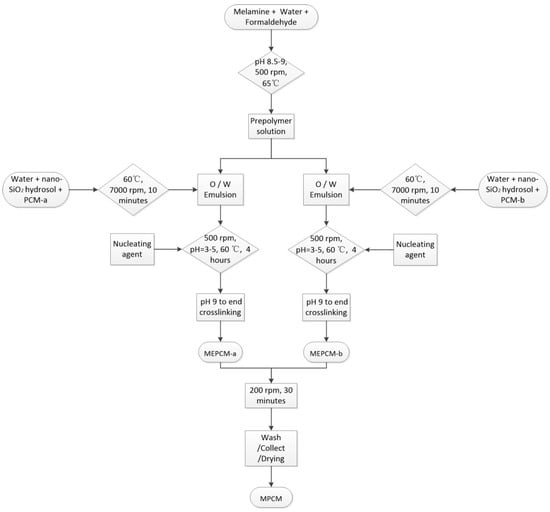
Figure 1.
Preparation process of MPCM by combining two MEPCMs in slurry.

Table 2.
Composition of MPCMs samples.
2.3. Characterization Methods
Characterization was carried out to analyse the properties and behaviour of the samples. Scanning electron microscope (SEM, Sigma VP Carl Zeiss Co., Ltd., Oberkochen, Germany) and energy-dispersive X-ray spectroscopy (EDS, Oxford X-act) were used to examine the microstructure and the chemical elements of the samples. Since the shell material (melamine-formaldehyde resin) is non-conductive, the capsules were first coated with a 5 nm gold layer by using Leica EM SCD500 (Leica Microsystems GmbH, Wetzlar, Germany) equipment to increase their electrical conductivity before the SEM test was carried out.
A differential scanning calorimetric (DSC) (EXSTAR SII DSC6220, SII Nanotechnology Inc., Chiba, Japan) equipment was used to determine their enthalpies of fusion and melting temperatures. According to our previous study, the DSC measurement results only showed a slight difference between the heating rates of 1 °C/min and 2 °C/min [], i.e., the difference between the melting points was only 0.1~0.34 °C. Therefore, the heating rate was set at 2 °C/min from 5 to 50 °C under an atmospheric environment.
Thermogravimetry (TG) tests were conducted with EXSTAR6000 TG/DTA6300 (SII Nanotechnology) equipment to examine the physical and thermal resilience of the samples in relation to their molecular structure. The tests were carried out within a heating range of 50 °C to 500 °C at a rate of 10 °C/min under nitrogen gas protection to avoid oxidation reactions in the air.
3. Results and Discussions
3.1. Structural Analysis of MEPCMs
Figure 2 represents the SEM results for the three fabricated MEPCM samples (i.e., MEPCM-Hep, MEPCM-Oct, and MEPCM-Eic). The samples show good morphology with smooth and uniform spherical shapes and no sign of particle agglomeration problems except for a few cracked capsules. They, however, appear well encapsulated within their shells. The results also established the particle diameter sizes as between the range of 10–40 μm, with an average shell thickness around 200 nm, as presented in Figure 2d–f.
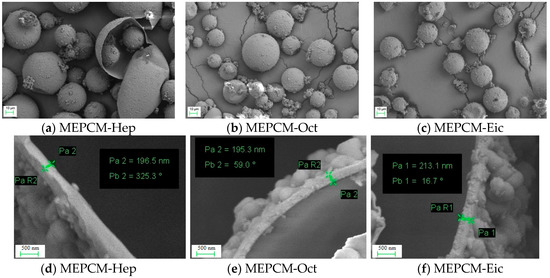
Figure 2.
SEM analysis results of MEPCM samples (a–c) is SEM image of MEPCM samples; (d–f) is shell thickness measurement by SEM through cracked capsules).
Meanwhile, analysis of the chemical elements of the samples revealed the presence of silicon (Si), carbon (C), nitrogen (N) and oxygen (O) as shown in Figure 3. The EDS examination results proved that the nano-silica particles were deposited in the capsule’s shells when nano-silicon dioxide hydrosol was used as a surfactant. This is because no other raw materials except silicon dioxide hydrosol contain chemical elements of silicon. This revelation also supports the fact that nano-silica particles, which have much higher thermal conductivity than paraffin and polymer shell, could be used to enhance the thermal conductivity of the MEPCM samples, as identified in our previous study [].

Figure 3.
Chemical elements of fabricated MEPCMs by EDS examination.
3.2. Thermal Energy Storage Analysis of Pure PCM and MEPCMs
The DSC profiles for the pure PCM and fabricated MEPCMs are presented in Figure 4 and Figure 5. The energy storage capacity and the corresponding melting temperatures were obtained as summarized in Table 3. Based on the initial core/shell weight ratio of 4:1 (see Table 1), the theoretical core material content in the MEPCMs should be equivalent to about 80% of the total material content. However, by using the measured enthalpies, the core material contents were obtained as 78.57%, 84.03% and 80.95% respectively. The differential core material content between the theoretical and experimental values was between 1.43–4.03% thus indicating fairly good encapsulation efficiency for the MEPCMs. There were also slight differences in the melting temperatures between the pure paraffin and the MEPCMs, which ranged from 0.19 °C to 0.75 °C. These changes are believed to have been caused by the presence of the nano-silica in the samples.
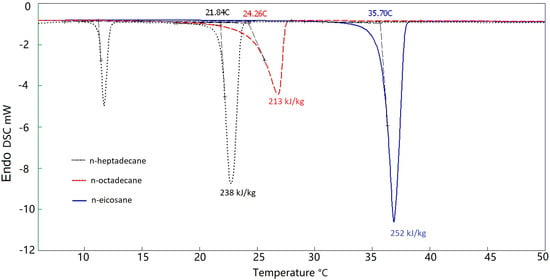
Figure 4.
Melting point and latent heat of n-heptadecane, n-octadecane and n-eicosane by DSC heating measurements.

Figure 5.
Melting point and latent heat of MEPCM-Hep, MEPCM-Oct and MEPCM-Eic by DSC heating measurements.

Table 3.
Thermal properties and behaviour of PCM cores and MEPCMs.
It is also noticed that the n-heptadecane displayed two peaks with the second peak starting at 21.84 °C and accounting for more than 80% of the total latent heat capacity for the whole phase change process. These two peaks are believed to have been caused by the presence of two different solid phases of odd-numbered alkanes in the n-heptadecane. The lower temperature peak corresponds to the ordered solid phase to disordered solid phase transition and the higher temperature peak represents the melting phase. This behaviour was also observed in other odd-numbered hydrocarbons linear alkane, such as n-pentadecane, n-heptadecane and n-nonadecane [], thus indicating the intrinsic characteristic nature of such materials. However, due to the much lower solid-solid phase change enthalpy and phase change mechanism, the melting point of the n-heptadecane was based on the second peak.
3.3. Thermogravimetric Analysis of Pure PCM and MEPCM Samples
The thermal stability of the MEPCMs is an important index to measure their durability and reliability in practical applications. Figure 6 and Figure 7 show the TG profiles for the pure PCM and MEPCM samples. The onset/endset temperature is defined as the initial/final weight loss temperature of the decomposition process in TG, respectively. The initial and final weight loss temperatures for the n-heptadecane, n-octadecane and n-eicosane were obtained as 106.6 °C/240 °C, 144.3 °C/265 °C and 177.6 °C/300 °C, respectively. However, the boiling points of n-heptadecane, n-octadecane and n-eicosane were 302 °C, 317 °C, and 344 °C, which are higher than the final weight loss temperatures. This means that the paraffin samples were fully evaporated before the boiling temperature was reached and therefore there was no material residual at the end of the maximum heating temperature of 500 °C. In comparison with the PCM samples, the weight loss curve of the MEPCMs demonstrates a different degradation behaviour. For instance, the weight loss of MEPCM-Oct between the range 209 °C and 310 °C is connected with the evaporation of the n-octadecane. The other weight loss between 310 °C and 500 °C is due to the shell decomposition. Therefore, the initial thermal stability of the three MEPCMs (MEPCM-Hep, MEPCM-Oct and MEPCM-Eic) did significantly improve with the second turning points extending to 270 °C, 310 °C and 370 °C, respectively (see Figure 7).
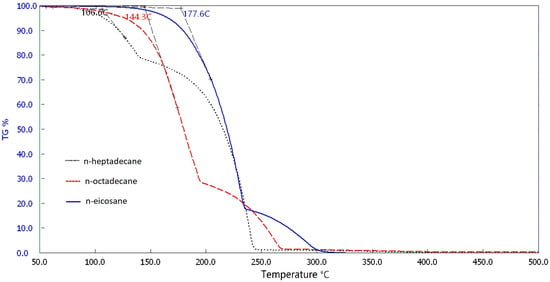
Figure 6.
Thermal stability analysis of n-heptadecane, n-octadecane and n-eicosane by TG.
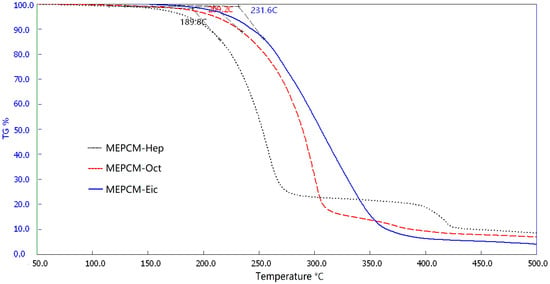
Figure 7.
Thermal stability analysis of MEPCMs by TG curves.
That means the final weight loss temperatures for the paraffin also increased by 30–70 °C after the encapsulation and that a certain amount of n-octadecane and n-eicosane were still in the MEPCM capsules even though the temperatures were higher than their boiling points. The MEPCM samples also achieved about 5–9% of material weight retention at the end of the maximum heating temperature of 500 °C due to the residual thermal decompositions of the PMF shell.
3.4. SEM Analysis of MPCMs
As described in the development of MPCMs in Section 2.2, the MPCM-1, MPCM-2 and MPCM-3 were prepared by combining EMPCM-Hep/MEPCM-Oct, MEPCM-Hep/MEPCM-Eic, and MEPCM-Oct/MEPCM-Eic, respectively. The three dried MPCM samples were observed by SEM to evaluate the integrity of the particles. The SEM results in Figure 8, do show good morphology and particle distribution profiling in all the three MPCM samples. The capsules do appear free from particle agglomeration issues, have no deformations, and are well encapsulated. However, it is noteworthy that some of the particles in MPCM-2 coalesced together. There were also some deformed particles which may have occurred during the mixing process but were of the same sizes as the MEPCMs in Figure 2, ranging between 10 and 40 μm. The SEM image also showed that the PCM core materials in the MPCM were protected from each and therefore expected them to be melted and frozen individually as confirmed by the DSC analysis.

Figure 8.
SEM images of MPCM-1, MPCM-2 and MPCM-3 samples.
3.5. Thermal Energy Storage Analysis of MPCMs
The MPCMs are expected to melt and solidify independently since the combined core materials are each encapsulated. Therefore, by using Equation (1) and the weight percentages and latent heat values of the MEPCMs, it should be possible to calculate the latent heat values of the fabricated MPCMs.
where; and are the latent heat components of and materials. and are the weight percentages of the components and respectively.
The calculation results are presented in Table 4. By considering a weight percentage of 50% for each of the MEPCMs, the theoretical latent heat values of MPCM-1, MPCM-2 MPCM-3 were obtained as 183 kJ/kg, 195.5 kJ/kg and 191.5 kJ/kg, respectively.

Table 4.
Theoretical and experimental thermal properties of MPCMs.
As expected from the experimental results in Figure 9, the melting points of the fabricated MPCM samples occurred at two different points. For instance, the MPCM-1 melted at 21.34 °C/23.49 °C which compare favorably with MEPCM-Hep/MEPCM-Oct at 21.65 °C/23.55 °C. The MPCM-2 sample melted at 21.65 °C/34.95 °C but was slightly decreased by 0.09–0.19 °C, while sample MPCM-3 occurred at 23.50 °C/34.91 °C with a reduction of 0.05–0.23 °C. In general, the maximum differential temperature between experimental and theoretical values for the three MPCM samples was only 0.31 °C.
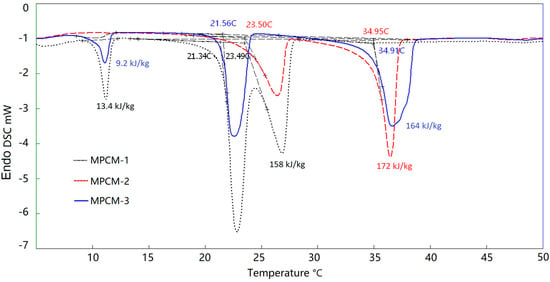
Figure 9.
Melting points and latent heats of MPCM-1, MPCM-2 and MPCM-3 sample by DSC heating measurements.
Meanwhile, the total latent heat was achieved as 171.4 kJ/kg, 173.13 kJ/kg and 172 kJ/kg for samples MPCM-1, MPCM-2 and MPCM-3 respectively. In comparison with the theoretical values in Table 4, the measured latent heat for three MPCM-1, MPCM-2 and MPCM-3 was reduced by 11.6 kJ/kg, 19.5 kJ/kg and 22.37 kJ/kg. The overall measured latent heat values for the three MPCM samples were reduced by about 6.3–11.4%, which might attribute to the broken shells observed in some of the capsules in Figure 8.
Therefore, it can be inferred that the MPCM samples were able to achieve multi-phase change temperatures. The mixing approach of the MEPCMs did not have a significant effect on the transitional phase change temperatures and the specific enthalpies of the individual PCMs. In comparison with the studies based on the direct mixing of binary core PCMs [,], the MPCMs were able to achieve multi-phase change temperatures and higher thermal energy storage capacity. However, the theoretical and the experimental DSC results in Table 4, confirmed that the thermal energy storage capacities were largely dependent on the latent heats of individual components and their corresponding weight percentages. By comparing the thermal properties of MPCM in Table 4, it can be indicated that MPCM samples had good thermal energy storage capacities by experimental testing and theoretical value with Equation (1). Thus, future research can be focused on the correlations between thermal energy storage capacities of the prepared MPCMs and the thermal properties and weight percentages of the original PCMs.
3.6. Thermal Stability Analysis of MPCMs
The SEM analysis revealed that the MPCMs particles achieved good structural integrities within the MF shells. Theoretically, the thermal stability temperatures of the MPCMs should not be less than the minimum temperature of the MEPCMs i.e., 189.8 °C. The thermal stability of the MPCM samples was also analyzed by using a TG analysis to evaluate the initial weight loss (onset) temperature. It can be observed from the test results in Figure 10 that, the weight loss temperatures of MPCM-1, MPCM-2 and MPCM-3 did indeed occur at higher temperatures from 197.8 °C, 202.4 °C and 218.8 °C, respectively. On the other hand, the second turning point of TG curves for MPCM samples reached 270 °C, 270 °C and 290 °C, respectively. These values are almost the same as the values for MEPCM-Hep and MEPCM-Oct, which were used to fabricate the MPCM samples. The MPCM samples also achieved about 7–9% of material weight retention at the end of the maximum heating temperature of 500 °C which is like what was achieved by the MEPCMs. Overall, the initial weight loss temperatures of MPCMs are also much higher than any natural ambient condition and therefore satisfy normal environmental requirements for buildings.
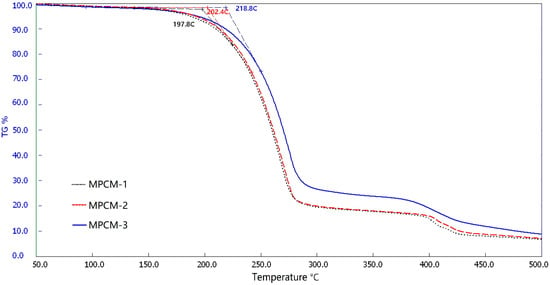
Figure 10.
Thermal stability analysis of MPCM-1, MPCM-2 and MPCM-3 samples by TG.
4. Conclusions
To overcome the seasonal storage limitations, this study has developed enhanced multiphase change materials by combining two different types of MEPCMs. As a result, this research has successfully produced three multiphase change materials to balance seasonal heating and cooling loads in buildings. Thermal analysis of the results clearly shows that it is possible to achieve multiple phase transitional temperatures with relatively good energy storage capacity and thermal stability. The measured energy storage capacities of the MPCMs were found to be largely dependent on the weight percentages of individual components. The specific findings may therefore be summarized as follows:
- In comparison with pure PCMs, the melting points of the MEPCMs were reduced by 0.19–0.75 °C after encapsulation.
- The differential core material content between the theoretical and experimental values for the MEPCMs was between 1.43–4.03%
- The phase change temperatures of the MPCMs were slightly reduced by 0.09–0.31 °C as compared with the MEPCMs samples.
- The measured energy storage capacities for the MPCM samples were reduced by about 6.3–11.4% as compared with the theoretical values. They however, displayed relatively good thermal stability behavior of up to 197.8–218.8 °C.
Even though the developed samples have shown the potential of being used for seasonal storage in buildings, there is the need for further work towards optimization of key material components by different weight percentages. Experimental investigations into methods of integration of samples into appropriate construction materials, and enhancement of thermal conductivities are also encouraged.
Author Contributions
Conceptualization, W.S. and J.D.; methodology, W.S. and J.D.; validation, W.S., J.D. and L.G.; formal analysis, W.S.; investigation, W.S.; writing—original draft preparation, W.S., J.D., T.Z. and G.K.; writing—review and editing D.D., Y.L., L.G. and L.W.; funding acquisition, W.S., J.D. and L.W. All authors have read and agreed to the published version of the manuscript.
Funding
This research was funded by Qing Chuang plan by Department of Education of Shandong Province (Sub-Title: Innovative Research Team of Advanced Energy Equipment); Science, Education and Industry Integration Innovation Pilot Project from Qilu University of Technology (Shandong Academy of Sciences) (No.2022JBZ02-01); UK Engineering, Physical Sciences Research Council (EPSRC) (under Grant Award No. EP/V041452/1). Shanghai Sailing Program (No. 20YF1432000).
Data Availability Statement
Data sharing not applicable.
Conflicts of Interest
The authors declare no conflict of interest.
Nomenclature
| C | carbon |
| DSC | differential scanning calorimetric |
| EDS | energy-dispersive X-ray spectroscopy |
| EGDS | ethylene glycole distearate |
| MEPCM | microencapsulated phase change material |
| MEPCM-Hep | MEPCM with n-heptadecane as a core |
| MEPCM-Oct | MEPCM with n-octadecane as a core |
| MEPCM-Eic | MEPCM with n-eicosane as a core |
| MPCM | multiphase change materials |
| N | nitrogen |
| O | oxygen |
| O/W | oil-in-water |
| PCM | phase change material |
| SEM | Scanning electron microscope |
| Si | silicon |
| TG | Thermogravimetry |
| Latent heat, kJ/kg | |
| latent heat of MEPCM-x, kJ/kg | |
| latent heat of MEPCM-y, kJ/kg | |
| tm1 | the first melting point of MPCM, °C |
| tm2 | the second melting points of MPCM, °C |
| tm | melting temperature, °C |
| the weight percentages of MEPCM-x, % | |
| the weight percentages of MEPCM-y, % |
References
- Da Cunha, S.R.L.; de Aguiar, J.L.B. Phase change materials and energy efficiency of buildings: A review of knowledge. J. Energy Storage 2020, 27, 101083. [Google Scholar] [CrossRef]
- Saafi, K.; Daouas, N. Energy and cost efficiency of phase change materials integrated in building envelopes under Tunisia Mediterranean climate. Energy 2019, 187, 115987. [Google Scholar] [CrossRef]
- Tunçbilek, E.; Arıcı, M.; Bouadila, S.; Wonorahardjo, S. Seasonal and annual performance analysis of PCM-integrated building brick under the climatic conditions of Marmara region. J. Therm. Anal. Calorim. 2020, 141, 613–624. [Google Scholar] [CrossRef]
- Zhang, H.; Xing, F.; Cui, H.-Z.; Chen, D.-Z.; Ouyang, X.; Xu, S.-Z.; Wang, J.-X.; Huang, Y.-T.; Zuo, J.-D.; Tang, J.-N. A novel phase-change cement composite for thermal energy storage: Fabrication, thermal and mechanical properties. Appl. Energy 2016, 170, 130–139. [Google Scholar] [CrossRef]
- Pilehvar, S.; Szczotok, A.M.; Carmona, M.; Pamies, R.; Kjøniksen, A. The effect of microencapsulated phase change materials on the rheology of geopolymer and Portland cement mortars. J. Am. Ceram. Soc. 2020, 103, 5852–5869. [Google Scholar] [CrossRef]
- Huseien, G.F.; Sam, A.R.M. Nanostructures encapsulated phase change materials for sustained thermal energy storage in concrete: An overall assessment. Mater. Today Proc. 2021, 42, 2457–2463. [Google Scholar] [CrossRef]
- Li, G.; Hwang, Y.; Radermacher, R.; Chun, H.-H. Review of cold storage materials for subzero applications. Energy 2013, 51, 1–17. [Google Scholar] [CrossRef]
- Podara, C.V.; Kartsonakis, I.A.; Charitidis, C.A. Towards Phase Change Materials for Thermal Energy Storage: Classification, Improvements and Applications in the Building Sector. Appl. Sci. 2021, 11, 1490. [Google Scholar] [CrossRef]
- Su, W.; Hu, M.; Wang, L.; Kokogiannakis, G.; Chen, J.; Gao, L.; Li, A.; Xu, C. Microencapsulated phase change materials with graphene-based materials: Fabrication, characterisation and prospects. Renew. Sustain. Energy Rev. 2022, 168, 112806. [Google Scholar] [CrossRef]
- Konuklu, Y.; Ostry, M.; Paksoy, H.O.; Charvat, P. Review on using microencapsulated phase change materials (PCM) in building applications. Energy Build. 2015, 106, 134–155. [Google Scholar] [CrossRef]
- Zhou, T.; Darkwa, J.; Kokogiannakis, G. Thermal evaluation of laminated composite phase change material gypsum board under dynamic conditions. Renew. Energy 2015, 78, 448–456. [Google Scholar] [CrossRef]
- Young, B.A.; Falzone, G.; Wei, Z.; Sant, G.; Pilon, L. Reduced-scale experiments to evaluate performance of composite building envelopes containing phase change materials. Constr. Build. Mater. 2018, 162, 584–595. [Google Scholar] [CrossRef]
- Berthou, Y.; Biwole, P.H.; Achard, P.; Sallée, H.; Tantot-Neirac, M.; Jay, F. Full scale experimentation on a new translucent passive solar wall combining silica aerogels and phase change materials. Sol. Energy 2015, 115, 733–742. [Google Scholar] [CrossRef]
- Tokuç, A.; Başaran, T.; Yesügey, S.C. An experimental and numerical investigation on the use of phase change materials in building elements: The case of a flat roof in Istanbul. Energy Build. 2015, 102, 91–104. [Google Scholar] [CrossRef]
- Zhu, N.; Liu, P.; Hu, P.; Liu, F.; Jiang, Z. Modeling and simulation on the performance of a novel double shape-stabilized phase change materials wallboard. Energy Build. 2015, 107, 181–190. [Google Scholar] [CrossRef]
- Zhu, N.; Liu, F.; Liu, P.; Hu, P.; Wu, M. Energy saving potential of a novel phase change material wallboard in typical climate regions of China. Energy Build. 2016, 128, 360–369. [Google Scholar] [CrossRef]
- Li, G.; Hwang, Y.; Radermacher, R. Cold Thermal Energy Storage Materials and Applications Toward Sustainability. In Energy Solutions to Combat Global Warming; Dincer, I., Zhang, X., Eds.; Springer: Berlin/Heidelberg, Germany, 2017. [Google Scholar]
- Su, W.; Darkwa, J.; Kokogiannakis, G. Numerical thermal evaluation of laminated binary microencapsulated phase change material drywall systems. Build. Simul. 2020, 13, 89–98. [Google Scholar] [CrossRef]
- Huang, Z.; Ye, Q.; Shi, Z.; Tang, J.-N.; Ouyang, X.; Chen, D.-Z. Multiple phase change-stimulated shape memory and self-healing epoxy composites with thermal regulation function. Chem. Eng. J. 2020, 409, 127382. [Google Scholar] [CrossRef]
- Meng, X.; Qin, S.; Fan, H.; Huang, Z.; Hong, J.; Xu, X.; Ouyang, X.; Chen, D.-Z. Long alkyl chain-grafted carbon nanotube-decorated binary-core phase-change microcapsules for heat energy storage: Synthesis and thermal properties. Sol. Energy Mater. Sol. Cells 2020, 212, 110589. [Google Scholar] [CrossRef]
- Ma, Y.; Chu, X.; Li, W.; Tang, G. Preparation and characterization of poly(methyl methacrylate-co-divinylbenzene) microcapsules containing phase change temperature adjustable binary core materials. Sol. Energy 2012, 86, 2056–2066. [Google Scholar] [CrossRef]
- Ma, Y.; Sun, S.; Li, J.; Tang, G. Preparation and thermal reliabilities of microencapsulated phase change materials with binary cores and acrylate-based polymer shells. Thermochim. Acta 2014, 588, 38–46. [Google Scholar] [CrossRef]
- Ma, Y.; Chu, X.; Tang, G.; Yao, Y. The effect of different soft segments on the formation and properties of binary core microencapsulated phase change materials with polyurea/polyurethane double shell. J. Colloid Interface Sci. 2013, 392, 407–414. [Google Scholar] [CrossRef]
- Wang, T.; Wang, S.; Luo, R.; Zhu, C.; Akiyama, T.; Zhang, Z. Microencapsulation of phase change materials with binary cores and calcium carbonate shell for thermal energy storage. Appl. Energy 2016, 171, 113–119. [Google Scholar] [CrossRef]
- Yataganbaba, A.; Ozkahraman, B.; Kurtbas, I. Worldwide trends on encapsulation of phase change materials: A bibliometric analysis (1990–2015). Appl. Energy 2017, 185, 720–731. [Google Scholar] [CrossRef]
- Su, W.; Darkwa, J.; Kokogiannakis, G. Development of microencapsulated phase change material for solar thermal energy storage. Appl. Therm. Eng. 2017, 112, 1205–1212. [Google Scholar] [CrossRef]
- Su, W.; Li, Y.; Zhou, T.; Darkwa, J.; Kokogiannakis, G.; Li, Z. Microencapsulation of Paraffin with Poly (Urea Methacrylate) Shell for Solar Water Heater. Energies 2019, 12, 3406. [Google Scholar] [CrossRef]
- Climate.OneBuilding.Org. China. 2021. Available online: http://climate.onebuilding.org/WMO_Region_2_Asia/CHN_China/index.html (accessed on 12 May 2023).
- Zhang, H.; Wang, X. Fabrication and performances of microencapsulated phase change materials based on n-octadecane core and resorcinol-modified melamine–formaldehyde shell. Colloids Surf. A Physicochem. Eng. Asp. 2009, 332, 129–138. [Google Scholar] [CrossRef]
- Su, W.; Gao, L.; Wang, L.; Zhi, H. Calibration of differential scanning calorimeter (DSC) for thermal properties analysis of phase change material. J. Therm. Anal. Calorim. 2021, 143, 2995–3002. [Google Scholar] [CrossRef]
- Su, W.; Darkwa, J.; Kokogiannakis, G. Nanosilicon dioxide hydrosol as surfactant for preparation of microencapsulated phase change materials for thermal energy storage in buildings. Int. J. Low-Carbon Technol. 2018, 13, 301–310. [Google Scholar] [CrossRef]
- Vélez, C.; de Zárate, J.M.O.; Khayet, M. Thermal properties of n-pentadecane, n-heptadecane and n-nonadecane in the solid/liquid phase change region. Int. J. Therm. Sci. 2015, 94, 139–146. [Google Scholar] [CrossRef]
Disclaimer/Publisher’s Note: The statements, opinions and data contained in all publications are solely those of the individual author(s) and contributor(s) and not of MDPI and/or the editor(s). MDPI and/or the editor(s) disclaim responsibility for any injury to people or property resulting from any ideas, methods, instructions or products referred to in the content. |
© 2023 by the authors. Licensee MDPI, Basel, Switzerland. This article is an open access article distributed under the terms and conditions of the Creative Commons Attribution (CC BY) license (https://creativecommons.org/licenses/by/4.0/).